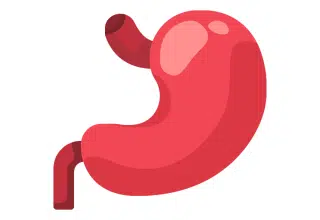
Summary of New Practice Guidance: Targownik LE, Fisher DA, Saini SD. AGA Clinical Practice Update on De-Prescribing of Proton Pump Inhibitors: Expert Review. Gastroenterology 2022 ;162(4):1334-1342
by Hanna Haddad, PharmD Candidate and Kathryn Litten, PharmD, BCACP
Proton pump inhibitors (PPIs) are commonly used to reduce stomach acid in patients with gastroesophageal reflux disease (GERD) and are readily accessible over the counter. Guidelines recommend PPIs for several indications and the recommended duration ranges from short-term use in peptic ulcer disease to long-term use for Barrett’s Esophagus and Zollinger-Ellison Syndrome. As these medications are widely prescribed to both ambulatory and hospitalized patients … and many patients take them without a prescription, unnecessary use has become commonplace. Patients often continue PPIs despite the lack of a clear indication, after symptoms have resolved, or even in situations where there is no expectation of benefit. All too often, it’s assumed continued PPI use is needed. No one takes the time to explore the indication or how long the patient has been taking it.
While they are generally considered to be well-tolerated and safe, they are not benign. PPIs have been linked to adverse effects (AE’s) such as chronic kidney disease, vitamin deficiencies, enteric infections (particularly Clostridium difficile), pneumonia, and bone fracture. Patients who take a PPI for a prolonged period of time are nearly 1.5 times more likely to develop chronic kidney disease, more than 2 times more likely to acquire pneumonia, and nearly 3 times more likely to become infected with Clostridium difficile.1 While the evidence directly linking PPI use to these AEs is controversial in some cases, the strong association with enteric infections is compelling and biologically plausible due to disruption of the gut microbiome.2
Given that prolonged PPI use increased the possibility of AEs, drug interactions, and increased cost, in absence of an indication, they should be discontinued. However, de-prescribing is challenging for a number of reasons, including provider awareness, patient resistance, and time. In one longitudinal cost analysis of 29,348 patients following hospital discharge found inappropriate prescribing and continuation of PPIs in 68.8% of patients! This led to more than 3 million dollars in excess cost 30 day-post discharge.3 Inappropriate prescribing further contributes to pill burden and polypharmacy. Studies have found over a quarter of older adults are taking a PPI, and almost half are not prescribed for evidence-based indications.4 While inappropriate use is common, it’s important to not prematurely de-prescribe a PPI when indicated. In one survey, physicians were given a patient scenario where the patients were at high risk for an upper GI bleed. Amazingly, nearly 80% of the participants in this study inappropriately recommended discontinuation of the PPI.5 Thus, uncertainty and confusion abound.
We clearly need better guidance about when and how to de-prescribe PPIs. The American Gastroenterological Association (AGA) recently released a Clinical Practice Update with 10 Best Practice Advice (BPA) statements to aid prescribers in making deprescribing decisions about PPIs.6 Their recommendations are organized into three key domains: documentation of a PPI indication; identifying suitable candidates for de-prescribing; and optimizing successful deprescribing.
Domain 1: Documentation of PPI indication
Patient assessment
Proper assessment and documentation of the PPI indication are critically important. PPIs use should be frequently reviewed (e.g. at every patient encounter) to determine if there is an ongoing indication, and those without a definitive indication should be considered for de-prescribing (BPA 1,2). Do not de-prescribe if ongoing treatment is indicated.
Domain 2: Identifying Suitable Candidates for Consideration of De-Prescribing
When to deprescribe?
If there is no guideline or FDA-recommended indication, consider deprescribing the PPI or decreasing the dose. For example, in most patients taking twice-a-day dosing, the dose should be reduced to once-daily dosing and re-evaluated so that it can eventually be discontinued (BPA 3). One caveat to this rule is Zollinger-Ellison syndrome, which does require higher twice-daily dosing. But Zollinger-Ellison is very uncommon.
When NOT to deprescribe?
Patients who have severe GERD symptoms or Barrett’s esophagus should continue their PPI (BPA 4,5). PPIs reduce the risk for upper gastrointestinal (GI) bleeds by decreasing gastric acid secretion, allowing ulcers time to heal, and stabilizing thrombi.7 Patients should be assessed for risk factors for GI bleeds using an evidence-based risk stratification tool and should include a review of co-morbidities, age, and medications (BPA 6,7). Common risk factors include those with a history of GI bleed, taking antiplatelets, or taking antithrombotic agents. Patients at persistent risk of a GI bleed may need gastroprotection with a PPI and should not be de-prescribed (BPA 7). The AGA Guidance Document includes multiple recommendations for gastroprotection (See Table 2 in the AGA Best Practice Advice).6 While there are several potential AEs with PPIs, the benefit of treatment generally outweighs the risk in these clinical scenarios. The experts strongly advise de-prescribing when there is a lack of an indication and not due to perceived risk or fear of potential AEs (BPA 10).
Domain 3: Optimizing Successful De-Prescribing
So how do you de-prescribe safely? It is reasonable to abruptly discontinue PPI therapy in most cases. However, patients who have taken long-term PPI therapy can experience rebound acid hypersecretion (RAHS) after abrupt discontinuation. When taking PPIs, the body compensates for the higher gastric pH and when the PPI is abruptly stopped, acid production is increased often to higher than what existed prior to therapy, thereby causing transient upper GI symptoms. To reduce this risk and promote successful deprescribing, practitioners should alert patients to this potential effect. It is also reasonable to suggest stepping down to an as-needed H2-receptor antagonist, antacid, or lower-potency (or dose) PPI. Another option is to taper the PPI (BPA 8,9). The AGA guidance panel cited one study that compared a 3-week taper (daily to every other day use) vs. abrupt discontinuation that documented a trend towards remaining off PPIs. Given it can take up to 6 months for the body to return to normal acid secretion, a longer, slower taper may be appropriate (but it’s not supported by evidence). If severe symptoms continue to persist after the patient has been off the PPI for 2 months, restarting PPI therapy is warranted and the indication for therapy should be re-assessed.
Lifestyle changes and nonpharmacologic strategies should be implemented as well to increase the likelihood of successful deprescribing. Patient education should include chewing food more thoroughly, eating smaller meals, and avoiding meals close to bedtime. Avoiding triggers such as fatty foods, carbonated drinks, and smoking may also be beneficial.8 Of course, smoking cessation is always beneficial, but this is yet another reason.
The Role of Pharmacists
The AGA specifically encourages physicians to partner with pharmacists to implement these BPAs to promote successful deprescribing of PPIs. Pharmacists are trained to perform comprehensive medication reviews to assess the risks and benefits of medication use. Pharmacists should proactively assess the patient for an indication for a PPI, rule out the need for gastroprotection, determine current symptom management, and begin a discussion with the patient and provider about the potential to de-prescribe the PPI. Pharmacists can help create a discontinuation plan which may include a dose tapering schedule, stepping down to an H2 antagonist, or using an acid-suppressing medication PRN. Pharmacists can warn patients about rebound symptoms (and how to manage them) as well as non-pharmacologic strategies that increase the chances of success. Working together, we can decrease the risk, cost, and polypharmacy associated with unnecessary PPI use.
Key Best Practice Statements from the American Gastroenterology Association on De-Prescribing PPIs
| 1 | Primary care providers should regularly review and document ongoing indications for PPI use in all patients taking a PPI |
| 2 | All patients without a definitive indication for chronic PPI should be considered for de-prescribing |
| 3 | Most patients who take twice-daily PPI should be considered for step down to once-daily dosing |
| 4 | Patients with complicated GERD should not be considered for PPI discontinuation |
| 5 | Patients with known Barrett’s esophagus, eosinophilic esophagitis, or idiopathic pulmonary fibrosis should generally not be considered for de-prescribing |
| 6 | Assess PPI users for upper GI bleeding risk before de-prescribing |
| 7 | Patients at high risk for upper GI bleeding risk should not be considered for PPI de-prescribing |
| 8 | Upon PPI discontinuation, advise patient they may develop transient upper gastrointestinal symptoms due to rebound acid hypersecretion |
| 9 | Consider dose tapering or abrupt discontinuation when de-prescribing |
| 10 | Base decision to discontinue PPIs on lack of indication for use, not due to concern for or risk of PPI-associated adverse events |
PPI: proton pump inhibitor; GERD: gastroesophageal reflux disease; PAAE: PPI-associated adverse events
References





 iForumRx.org is a web-based community of practice designed to inform ambulatory care pharmacy specialists, pharmacy residents, and student pharmacists about high-quality, practice-changing evidence.
iForumRx.org is a web-based community of practice designed to inform ambulatory care pharmacy specialists, pharmacy residents, and student pharmacists about high-quality, practice-changing evidence.